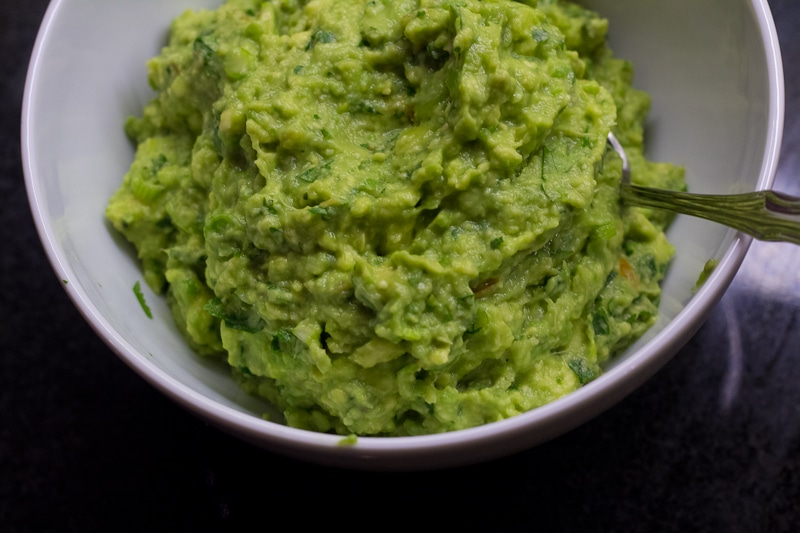Paleo Guacamole That Stays Green: Salt-Water Soak Method

Now, this Paleo guacamole is so delicious that there’s a chance it won’t last long enough to oxidize and get ugly. I’m sure you have your favorite guacamole combination, and it’s fine to use the trick I’m about to share with you on your own favorite recipe. However, you should know that many people have tried this recipe and declared it the best guacamole they’ve ever had. Spoiler alert: tomatoes, while one of my most favorite foods are not necessary for guacamole. They’re just not. I promise, especially in the middle of winter. I DARE you to bring me a tomato worth eating. Just leave them out, and let the avocados be the star. In fact, leave out anything that isn’t green. Red onion? No. Raw red onions ruin everyone’s day. I know, I know. I’m pushing the limits of your guacamole comfort zone. Trust me, I’m a pro. I know what I’m doing. The trick to keeping your guacamole green is soaking the avocados in salt water.
Paleo Guacamole That Stays Green: Salt-Water Soak Method, Brine, and Ingredients
| Component | Specification |
|---|---|
| Salt-water pre-soak | 2 cups water + 1⁄4 cup sea salt, dissolve fully |
| Avocados | 3 ripe, peeled, pitted, halved |
| Cilantro | Small handful, minced, about 3 tablespoons |
| Lime juice | Juice of 1 lime, about 2 tablespoons |
| Scallions | 3, white and light green only, finely diced |
| Jalapeño | 1, minced. Seed and membrane removed for mild, left in for spicy |
Method
Dissolve sea salt in water in a large bowl. Submerge the peeled, pitted avocado halves for 15 minutes. While they soak, mince cilantro and jalapeño, and dice the scallions. Lift the avocados out, quickly rinse the bowl to remove residual brine, return the avocados to the clean bowl, add lime juice, cilantro, scallions, and jalapeño, then mash with a whisk until the texture is partly smooth and partly chunky. Serve at once.
Why this works
Avocado browning is driven by polyphenol oxidase activity at cut surfaces. High ionic strength at the surface from a brief salt soak limits oxygen diffusion and enzyme activity while also tightening cell structure for a cleaner mash. The short exposure seasons the outer layer without over-salting, especially once excess brine is discarded and the bowl is rinsed before mashing.
Flavor and texture notes
The absence of tomatoes concentrates avocado flavor and prevents winter tomatoes from diluting texture. Scallions supply an allium snap without the sharpness of raw red onion. Lime provides acid balance and slows oxidation further. Jalapeño delivers a green heat that complements cilantro without adding non-green pigments.
Serving and pairing
PPair the paleo guacamole with crisp raw vegetables such as jicama batons and daikon rounds. Alternatively, assemble a taco spread with plantain tortillas and seasoned meats. Keep portions small to minimize surface area and browning on the table.
Make-ahead, storage, and browning control
Transfer leftovers to a shallow container, then press parchment or plastic wrap directly onto the surface to exclude air, and refrigerate. For short holds, drizzle a very thin layer of lime juice on the surface under the film. Stir before serving and re-check seasoning. Best within 24 hours.
Adjustments and substitutions
| Goal | Adjustment |
|---|---|
| Milder heat | Remove seeds and membranes from jalapeño or use half a pepper |
| Brighter acid | Add up to 1 extra teaspoon of lime juice at the end |
| Salt sensitivity | Reduce the soak to 10 minutes and add salt to taste while mashing |
| Cilantro-averse guests | Replace with minced flat-leaf parsley and a pinch of ground coriander |
Paleo Guacamole: Troubleshooting
If the paleo guacamole tastes overly salty, increase the lime juice by 0.5 to 1 teaspoon and fold in an additional half avocado, if available. If the texture is too loose, chill for 10 minutes to firm. If browning appears on the surface during service, smooth the top and apply a light squeeze of lime, then cover briefly.
